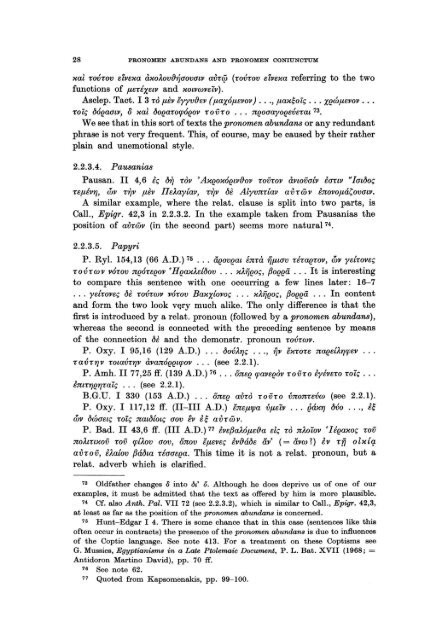Pronomen Abundans and Pronomen Coniunctum. A ... - DWC
Pronomen Abundans and Pronomen Coniunctum. A ... - DWC
Pronomen Abundans and Pronomen Coniunctum. A ... - DWC
You also want an ePaper? Increase the reach of your titles
YUMPU automatically turns print PDFs into web optimized ePapers that Google loves.
28 PRONOMEN ABUNDANS AND PRONOMEN CONIUNCTUM<br />
xal ToVTOV elvexa àxo"'ov~O'OVO't'JI aVTqJ (TOVTOV elvexa refeITing to the two<br />
functions of f-leTÉxetv <strong>and</strong> XOt'JIwveiv).<br />
Asclep. Tact. I 3 TO f-lèvlyyv{}ev (f-laxóf-levov) ..., f-lax~oiç .•. Xf!Wf-lE'JIOV ...<br />
Toiç Mf!aO't'JI, () xal 60f!aTorpÓf!OV TOVTO ••• nf!oO'aYOf!eVeTat 73.<br />
We see that in this sort of texts the pronomen alJundans or any redundant<br />
phrase is not very frequent. This, of course, may be caused by their rather<br />
plain <strong>and</strong> unemotional style.<br />
2.2.3.4. Pausanias<br />
Pausan. II 4,6 lç 6ij TOV ' AXf!oxóf!t'JI'{}ov TOVTOV àvwvatv lO'Tt'JI "Iat60ç<br />
uf-lév'YJ, div -riJv f-lèv IIeÄaylav, Tijv 6è AlyvnTlav aVTwv lnovof-lá!;ovO't'JI.<br />
A similar example, where the relat. clause is split into two parts, is<br />
CaU., Epigr. 42,3 in 2.2.3.2. In the example taken from Pausanias the<br />
position of m3Twv (in the second part) seems more natural 74 .<br />
2.2.3.5. Papyri<br />
P. Ryl. 154,13 (66 A.D.) 75 • •• aeovf!at ÉnTà f'Jf-ltO'v Tha(!TOV, div yslToveç<br />
T 0 V T W V VÓTOV nf!óuf!ov • H f!u>e"'el60v . . . x"'ijf!oç, fJof!f!ä . . . It is interesting<br />
to compare this sentence with one occuITing a few lines later: 16-7<br />
. .. yslTovsç 6è TOVTWV VÓTOV Baxxlovoç . . . x).ijf!oç, fJof!f!ä . . . In content<br />
<strong>and</strong> form the two look v~ry much alike. The only difference is that the<br />
fust is introduced by arelat. pronoun (foUowed by a pronomen abundans),<br />
whereas the second is connected with the preceding sentence by means<br />
of the connection 6è <strong>and</strong> the demonstr. pronoun TOVTWV.<br />
P. Oxy. I 95,16 (129 A.D.) ... 60v).'YJç ..., fjv lXTOU na(!el"''YJrpsv ...<br />
TavT'YJv TOtavT'YJv àvanóf!f!trpov .. . (see 2.2.1).<br />
P. Amh. II 77,25 ff. (139 A.D.) 76 .•• onsf! rpaVSf!Ov TOVTO lyévsTO Toiç ...<br />
È1I:tT'YJf!'YJTaiç ... (see 2.2.1).<br />
B.G.U. I 330 (153 A.D.) ... onsf! aUTO TOVTO vnonuvw (see 2.2.1).<br />
P. Oxy. I 117,12 ff. (II-III A.D.) lnsf-ltpa vf-leiv ... éáx'YJ Mo ..., È~<br />
div 6wO'stç Toiç natMotç O'ov lv È~ aVTWV.<br />
P. Bad. II 43,6 ff. (III A.D.) 77 lvsfJaMf-ls{}a elç TO n).oiov 'Uf!axoç TOV<br />
nOAtTtUOv TOV cplAov aov , önov lltEVeç È,,{}áóe ä,,' (= ällw 1) tv Tij ol,,{q.<br />
aVTOV, È"'alov fJá6ta TÉO'O'Sf!a. This time it is not arelat. pronoun, but a<br />
relat. adverb which is clarified.<br />
73 Oldfather changes 0 into b,' ö. Although he does deprive us of one of our<br />
examples, it must be admitted that the text as offered by him is more plausibIe.<br />
74 Cf. also Anth. Pal. VII 72 (see 2.2.3.2), which is similar to CaU., Epigr. 42,3,<br />
at least as far as the position of the pronomen abundans is concerned.<br />
75 HUDt-Edgar I 4. There is some chance that in this case (sentences like this<br />
of ten occur in contracts) the presence of the pronomen abundans is due to influences<br />
of the Coptic language. See note 413. For a treatment on these Coptisms see<br />
G. Mussies, Egyptianisms in a Late Ptolemaic Document, P. L. Bat. XVII (1968; =<br />
Antidoron Martino David), pp. 70 ff.<br />
76 See note 62.<br />
77 Quoted from Kapsomenakis, pp. 99- 100.
















